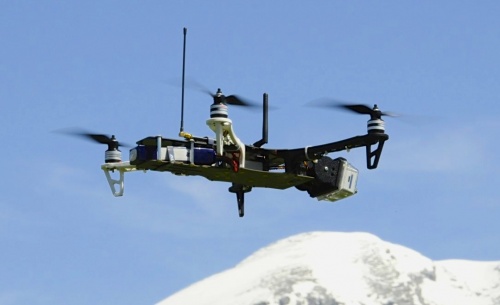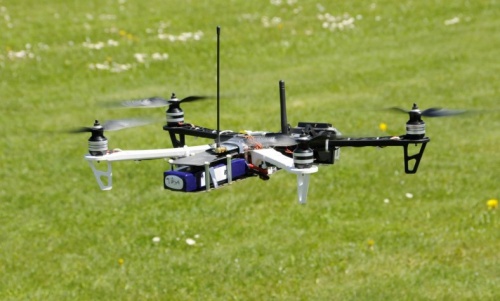Difference between revisions of "TBS Discovery"
| Line 123: | Line 123: | ||
* Change the throttle curve, either in OpenPilot (preferably) or on the radio, to be flat in the middle to reduce the change in throttle versus the stick movement, this should smooth your throttle response and allow for easy altitude adjustment - see pic [http://forums.openpilot.org/topic/7171-throttle-curve/#entry34052] | * Change the throttle curve, either in OpenPilot (preferably) or on the radio, to be flat in the middle to reduce the change in throttle versus the stick movement, this should smooth your throttle response and allow for easy altitude adjustment - see pic [http://forums.openpilot.org/topic/7171-throttle-curve/#entry34052] | ||
* Reduce the top throttle point to 90% to make sure the flight controller can take over control when throttle stick is at full | * Reduce the top throttle point to 90% to make sure the flight controller can take over control when throttle stick is at full | ||
* In DJI NAZA Assistant setup, start off using basic rate gain 150/155/120/100 and for attitude gain 125/125, then adjust as needed [http://fpvlab.com/forums/showthread.php?5371-TBS-DISCOVERY-New-quadrocopter-frame&p=121392&viewfull=1#post121392] | * In DJI NAZA Assistant setup, start off using basic rate gain 150/155/120/100 and for attitude gain 125/125, then adjust as needed [http://fpvlab.com/forums/showthread.php?5371-TBS-DISCOVERY-New-quadrocopter-frame&p=108872&viewfull=1#post108872] [http://fpvlab.com/forums/showthread.php?5371-TBS-DISCOVERY-New-quadrocopter-frame&p=121392&viewfull=1#post121392] | ||
== Build logs == | == Build logs == | ||
Revision as of 19:52, 23 July 2012
The Team BlackSheep (TBS) Discovery is a purpose made FPV platform based on the DJI Flame Wheel F450 frame base.
It has a asymmetric structure to offer a propeller free view, incorporates traces on the central core plates to minimize wiring, has space for both a flight camera and HD recording camera (GoPro) in the front and a protective cage for a high capacity LiPo battery in the back.
Researched only
Specifications
- Released:
- DJI Flame Wheel: November 2011
- TBS Discovery: June 2012
- Type: Spider quadrotor
- Airframe: Caron fiber reinforced
- Diameter: 450 mm - Flame Wheel, Discovery is a bit wider
- Height: xx mm
- Weight: 460 grams [1]
- Takeoff weight: 800 grams to 1600 grams
- Propellers: 10 × 4.5 in or 8 × 4.5 in
- Battery: 3S-4S LiPo
- Motor: 22×12 mm or 22×15 mm
- ESC: 30A switched
- Recommended flying area: 25x25 meters
- Product pages:
- Clone models: HJ450, RM450 and Q450 [2]
- DJI Hobby - Flame Wheel kits and NAZA flight control
- Team BlackSheep - TBS Discovery FPV specific base
Frame kit
The quad is build using separate base plates and frame arms. In other words, it is a purpose built kit using the DJI Flame Wheel arms for structural support and TBS Discovery plates for the central core and electronics installation.
- 1x DJI F450 Motor+Propellers+ESC+NAZA kit - from Flying-Hobby
- Alternatively:
- 2x DJI F450 Flame Wheel black arm - from Flying-Hobby
- 2x DJI F450 Flame Wheel white arm - from Flying-Hobby
- 1x TBS Discovery top and bottom plate including screws and damping tape - from TBS
- 1x TBS CORE video power distribution and OSD system - from TBS
- 1x TBS 100A current sensor - from TBS
- 1x TBS RF Tin Shield for TBS CORE - from TBS
Manual
- TBS CORE manual - power distribution for the video system
- DJI F450 Flame Wheel user manual - basic setup instructions for the Flame Wheel
- DJI NAZA Assistant user manual v1.4 - configure the flight controller
- DJI NAZA Assistant user manual v2.1 - configure the flight controller
My setup
Base setup
This is the basis for the quad and makes for a perfect platform to start testing equipment.
- Motor: RCTimer A2830-14 750 KV outrunner motor with 5.0 mm collet adaptor for 3.17 mm shaft [3]
- Propellers: Graupner E-Prop 10x5 inch propeller set [4]
- Alternate propellers: Gaui G-222800 10-inch propeller set (for GAUI 500X quad) [5]
- ESC (4x): Hobby King F-30A Brushless Programmable ESC with bare leads - reprogrammed with RapidESC firmware
- Alternate ESC: RCTimer 30A Brushless Programmable ESC with bare leads, internal oscillator (not optimal) - reprogrammed with RapidESC firmware
- Flight Controller: DJI NAZA no-GPS flight controller
- Receiver: FrSky D6FR 2.4 GHz ACCST 6 channel two-way receiver
- Transmitter: Spektrum DX7 radio with FrSky DHT 2.4 GHz 60mW transmitter
- Battery: Turnigy nano-tech 3300mah 35~70C 4SP1 14.8V Lithium-ion Polymer xx grams battery
Upgraded setup
- Motor: RCTimer A2830-14 750 KV outrunner motor [6]
- Receiver: ImmersionRC EzUHF Lite 8 channel 433 MHz receiver with Sander Style UHF antennas
- Transmitter: Spektrum DX7 radio with ImmersionRC EzUHF 433 MHz transmitter
- Flight Controller: OpenPilot CopterControl flight control - limited availability
Motor combinations
This is a list of verified setup from people who has built their Diso.
- RCTimer A2830-14 750 KV 185W outrunner motor
- NTM 28-30A 750 KV 140W prop drive series motor
- NTM 28-26A 1200 KV 250W prop drive series motor
- DJI 2212 920 KV 144W brushless motor [15]
- Suppo 2810/12 1000 KV 225W brushless motor
- Suggested setup: Graupner E-Prop 10x5 set, DJI OPTO 30A ESCs, DJI NAZA controller [18]
- Suppo 2814/8 1000 KV 380W brushless motor
- Suggested setup: Graupner E-Prop 9x5 set, DJI OPTO 30A ESCs, 4S 3000mAh+1800mAh, DJI NAZA controller [19]
- Tiger MT-4006-13 740 KV motor - no punch, vibration free
- Graupner Compact 300 740 KV 9.6V - expensive
- Suggested setup: Graupner ESC 18-SC, DJI NAZA controller, Nano-tech 4S 3300mAh [23]
Potential other candidates:
- TorxPower MC2216 Pro 900 KV 210W brushless motor [24]
- NTM 28-26 1350 KV 310W prop drive series motor [25]
- NX-4008 620 KV Brushless quadcopter motor [26] [27]
- FM-4008 620 KV Brushless quadcopter motor [28]
- Avroto M2814-11S Short Shaft 770 KV 350W Brushless motor [29]
- Tiger Motors MT-2216-10 900 KV 210W brushless motor [30]
Accessories
- USBasp AVR Programming Device for Atmel controllers - Hobby King
- 3M Double-sided tape pack - Hobby King
Tips and tricks
- To get rid of vibrationse, use only good quality propellers, e.g. Graupner [31] [32]
- For longer flight times, use low Kv motors and large propellers but watch the power usage
- To avoid propellers in the GoPro view, use Wide setting for 8-inch propellers and Medium for 10-inch propellers
- A 25A ESC is more than enough for this frame, max. 60A full throttle for all four controllers equals 15A per ESC, 10A margin [33]
- To a clean ESC install, solder the 3.5 mm socket motor connectors directly on the controller board [34]
- The standard DJI motor and propellers use a 8 mm shaft/bell, APC props are 6 mm and has to be adjusted, Graupner is 8 mm [35]
- Program the ESCs to be set up with Break off, Battery type NiMh (to turn off LiPo voltage cut-off), Cut-off type: soft cut, Cut-off voltage low, Aircraft type airplane, Start mode normal, Timing/response mode high (400 Hz), Governor off and everything else off [36] [37]
- Calibrate the throttle range for each ESC individually by setting the throttle stick high on power on and then low until a confirmation beep is heard
- Consider upgrading the ESC firmware to SimonK version get the full refresh rate needed for multirotors, RapidESC database shows all capable controllers
- Propeller thrust is only the amount a motor can carry/load, not at which speed, so therefore thrust determines the acceleration, kV determines the speed range [38]
- Only connect one BEC 5V power supply from a single ESC, disconnect the red power lead from the other three ESCs [39]
- On the flight controller, set Kp (instantaneously proportional error correction) to a high value to make the quad responsive and decrease 20% when it oscillates/nags, set Ki (integral/sum errors over time) to a high value to make it steady in windy, improper center of gravity, fast forward or long dives/turns, situations where the quad is off level for a fairly long period, decrease 20% when long slow oscillations occur [40]
- Since the front two arms are asymmetrical, increase pitch Kp and Ki with 1/3 of the value for roll (for OpenPilot) [41]
- On NAZA, set up signal loss fail-safe so that throttle is above 10% and that flight mode is put to 70% or the position NAZA will go into fail-safe mode, one less fall from the sky to worry about [42]
- In a dive the back-end of the Discovery might not fall as quick as the front, a way to counter this might be to set Ki for pitch (OpenPilot) to higher value to correct for the lack of power to the front motors [43]
- The results on eCalc might show "over power", but since this is a multirotor the load is shared and only in bust/acceleration moments will the motors be taxed [44]
- If the motors stall, try to increase the battery voltage, e.g. go from 3S to 4S batteries to increase/up the torque of the motors [45]
- Balance the motor by attaching a zip-tie spinning the motor up, stop and move the zip-tie and try again, the point of least vibration is the point where centre of rotation and mass is close to zero [46]
- Change the throttle curve, either in OpenPilot (preferably) or on the radio, to be flat in the middle to reduce the change in throttle versus the stick movement, this should smooth your throttle response and allow for easy altitude adjustment - see pic [47]
- Reduce the top throttle point to 90% to make sure the flight controller can take over control when throttle stick is at full
- In DJI NAZA Assistant setup, start off using basic rate gain 150/155/120/100 and for attitude gain 125/125, then adjust as needed [48] [49]
Build logs
For details on building and setting up the Discovery, take a look at the pages below for an idea.
- juz' OpenPilot build log
- Enthlapy's OpenPilot build log
- meme's build log
- Rensen's DJI Build Log
- Traveller's Disco build adventure
- kloner's TBS Discovery build log
- olivier30900 NAZA GPS build log
- WiseDuck NAZA build log
- isotop NAZA low cost build log
Also follow TBS Discovery quadcopter thread on FPVLab.
Tools
- eCalc - find the optimal propeller+motor combination
Shops
- teamblack-sheep.com - Home of TBS Zephyr I & II, Discovery and CORE, AU
- rctimer.com - Lots of motors, ESCs and clone Flame wheel, CN
- flying-hobby.com - Good selection of DJI items and great prices, HK
- goodluckbuy.com - DJI items and a lot of other accessories, HK
- uavproducts.com - Source for DJI kits and frames, US
- hobbyking.com - Motors, ESCs, batteries and a lot more, HK
- hobby-wing.com - DJI parts and clones, HK
- globe-flight.de - Multicopter items, FPV equipment, propellers, DE
- servocity.com - Pan and tilt systems
- addictiverc.com - Source of Graupner propellers, US
- elecricwingman.com - Another source of Graupner propellers, good prices, UK
- gothelirc.com - APC, Gaui, Graupner propellers, US
Video
This is the official Team BlackSheep video of the final production frame.

